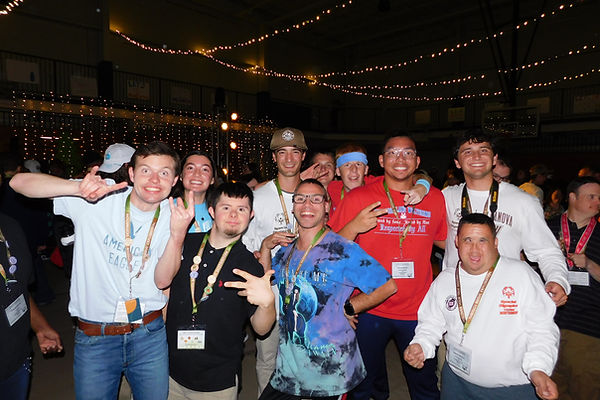What to Know for Volunteers

How to Support Our Athletes
Supporting athletes can come in a variety of ways due to the variety of abilities our athletes have. Support for one is going to look a lot different than support for another. Below we have collected resources and summarized some ways to build your confidence as a volunteer during Fall Fest!

Inclusive Language
Language Guidelines
The following language guidelines have been developed by experts in the field of intellectual disabilities for use by anyone writing or speaking about persons with mental retardation or closely related developmental disabilities, to ensure that all people are portrayed with individuality and dignity.
Use the following correct terminology:
-
Down Syndrome has replaced Down’s Syndrome and mongoloid.
-
Physically challenged or disabled rather than crippled.
-
Someone who is partially sighted is visually impaired rather than blind.
-
A person has a seizure rather than a fit.
-
A person has a seizure disorder or epilepsy, rather than is epileptic.
-
Distinguish between adults and children with intellectual disabilities, and older or younger athletes.
-
Refer to people in Special Olympics as athletes. The word athletes should not appear in quotation marks.
-
When writing, refer to persons with a disability in the same style as person without a disability: full name on first reference and last name on subsequent references.
-
A person uses a wheelchair rather than is confined or restricted to a wheelchair.
Do not use the following terminology:
-
Do not use the word kids when referring to Special Olympics athletes. Adult athletes are an integral part of the program.
-
Do not use the adjective unfortunate when talking about persons with intellectual disabilities.
-
Do not use the word “the” in front of Special Olympics unless describing a specific Special Olympics event.
-
Do not sensationalize the accomplishments of people with a disability. While these accomplishments should be recognized and applauded, people in the disability rights movement have tried to make the public aware of the negative impact of referring to the achievements of physically or mentally challenged people with excessive hyperbole. Do not overuse the word special when referring to persons with intellectual disabilities. Their accomplishments should not be trivialized by using cute words to describe their efforts.
-
According to Special Olympics Inc.’s charter with the International Olympic Committee, we are not to use the term Olympian. This means that we must not refer to the athletes as Special Olympians, but rather as Special Olympics athletes.
Practice:
Person First Language
Please watch this video from SOPA to learn more about how to use inclusive language!
Types of Disability
Neurodiversity
-
Every brain work differently from person to person
-
Due to this variation, people have different skills, needs, and abilities.
-
In the past, neurodiversity was associated with deficits in brain function.
-
However, we now recognize that the idea of neurodiversity brings strength to those who may experience the world differently than most.
-
While we all think differently, neurodivergent mainly describe those who have a more profound difference between their strengths and weaknesses.
-
Recognize the uniqueness of everyone's abilities, skills, & needs
-
Educate yourself about how to be a better disability all & open your mind when listening to us!
-
Consider if your environments are inclusive & accommodating.
-
Are there quiet spaces for people who may process sensory input differently?
-
Understand that neurodiversity (& disability) is diverse & complex.
-
Something that may be accommodating one person, may not be accommodating to another person (try to find a happy medium)!
How to
Support?

Adapt-Ability
Patience & Understanding in Interactions
-
Changing the ways of your world with intention and purpose
-
Conversations, Thoughts, Movements, etc.
-
-
“Only UP” when interacting with people with disabilities
-
U=Understanding ; P=Patience
-
-
Spread these ideas of adaptability to those who may be less knowledgeable and have less experience with a disabilities lens in their world.
American Sign Language
1
-
Sign language is not universal, meaning deaf individuals from different countries use different sign languages.
-
American Sign Language (ASL) is the most common sign language used in the U.S.
-
Words are expressed through manual articulation (hand signs) in combination with non-manual markers (includes facial expressions).
2
-
When watching someone sign, don’t just look at their hands because you will miss important non-manual markers!
-
Use your dominant hand when signing
-
If you are ambidextrous, pick one hand to be your dominant hand and be consistent
-
-
Don’t leave out facial expressions and body movements as they convey important information!
3
-
ASL I & II courses at Villanova
-
Dr. Heidi Rose (heidi.rose@villanova.edu)
-
-
Disabilities & Deaf Studies Program
-
Dr. Christa Bialka (christa.bialka@villanova.edu)
-
-
Signed with Heart on Youtube
-
Videos teaching basic ASL & Deaf culture
-
-
Signs from ASLU on Youtube





